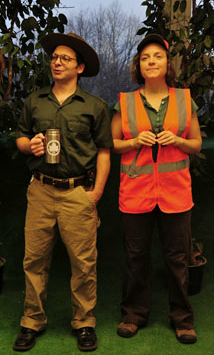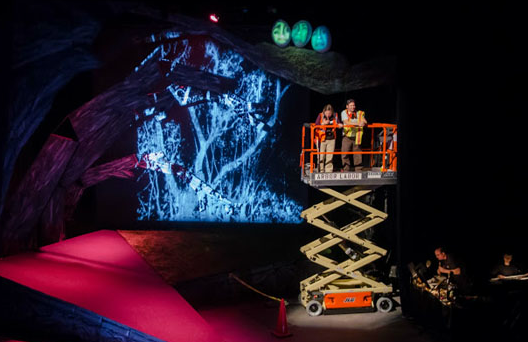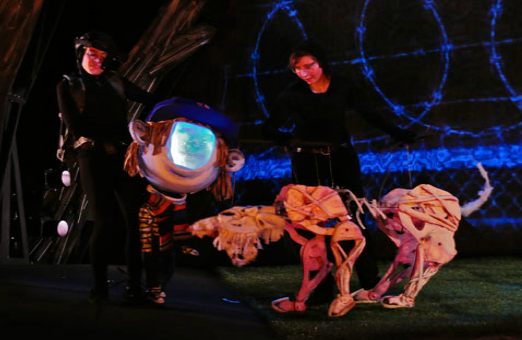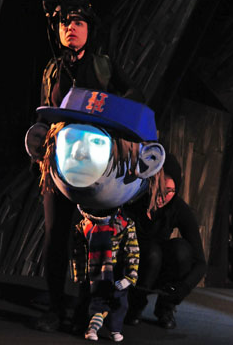INTERVIEW: ADHESIVE THEATER PROJECT and THE SERVICE ROAD, A Contemporary Myth
http://www.adhesivetheater.com

Frank, the park ranger, played by Cory Einbinder, and Lia, the park guide, played by Kalle Macrides.
Kalle Macrides has a background in playwriting, fiction writing, and acting. She completed Mac Welman’s MFA in Playwriting program at Brooklyn College. She also holds an MA in Performance Studies form NYU. For her undergraduate degree, she focused on acting and the social sciences at Sarah Lawrence College.
Cory Einbinder is an actor, director, designer, and creator. He received an MFA from Brooklyn College’s Performance and Interactive Media Arts program (PIMA) as well as a BFA in Theater Arts from University of the Arts. His interests span interactive video technology, set design, puppet design, prop design, stage combat choreography, acting, and directing.
How did you come to work together?
We met performing in a wacky production of William W. Pratt’s temperance drama Ten Nights in a Bar-room, directed by Ian W. Hill and produced by Untitled Theater Company #61 at the now defunct Nada theater. We’ve been making art as a couple ever since.
What inspired your vision of The Service Road?
We’ve been both friends with and fans of Erin Courtney for years. Two years ago we approached her about writing a piece for us to perform in together. Cory actually had a vision of the video-puppet at that time, which he shared with Erin. It’s hard to say who was more excited about it. From there, Erin used her knowledge of us to inform her writing. We both love being in nature, and at the time our son was obsessed with birds. He wasn’t speaking so much yet, but he could identify any of the 100+ birds of Prospect Park listed in an Audubon guide. Erin also knows we’re fans of myth, and so she eventually brought in the Hercules saga as a way to structure the piece.
- Lia and Gus on the Cherry Picker search for the lost boy as the Tree Children watch.
What was your process in creating the work?
We had several initial meetings with Erin. Then, in June of 2012, we began meeting regularly with her and director Meghan Finn to develop the piece. This involved anything from simply reading what Erin had written to her giving us writing assignments that, in bits and pieces and in one form or another, found their way into the play. Sometimes these assignments involved generating lists: activities we associate with Prospect Park, plants and animals of the park, favorite places within the park. Sometimes she asked for personal anecdotes from the park. Sometimes it was research: Hercules, or emergency procedures for the park. Erin took all this raw material and crafted it into the piece. And she worked on it throughout. In fact, we received a new scene on opening, and just finished rehearsing it before curtain! Very exciting.
How did the piece evolve? What were the challenges: What were the surprises? How did the audience respond?
Just as the script needed to evolve, so did the technology. Meghan would joke that every rehearsal was a tech, and indeed it often felt that way. We had a lot of kinks to work out with the video puppets, and making them run smoothly and consistently was, in fact, our greatest challenge. And of course, no matter how much you test a new technology before opening, surprise glitches are inevitable. Our student crews had to brainstorm and troubleshoot on their feet when technical problems arose during the run.
Our main concern, with every show that we do, is that the technology feel integrated into the piece; we don’t want it to distract or detract from the narrative. The production definitely was sensorial, and the spectacle that took place seemed to help the audience relate to the extreme and heightened situation the characters found themselves in within the piece.
What are your influences?
The technology for the puppets was inspired by the work of Tony Oersler. In terms of theatrical influences, we’re all fans of Big Dance Theater and The Debate Society.
Where do you see contemporary performance at and where do you see it going? What do you think the next generation is looking for in a performance?
There seems to be a real golden period for new works right now, and they run the gamut. There’s the camp that’s deeply interested in investigating the quotidian, finding complexity in simple moments. Then there are folks who are interested in theatrical theater, theater that engages the senses. For sure, we think audiences are looking for new works, and while we would put ourselves in the latter camp, there’s certainly audience for both.
What are your plans for the future?
We have a few different projects in mind. We’re talking with Charles Mee right now. We’re also in the early stages of writing a play together. And we’re contemplating having a second child. So I guess we’re planning on great sleep deprivation and deeply ambitious endeavors.
Related article: CYBORG ALICE: Cyborgs and Erin Courtney’s The Service Road by Joshua Bastian Cole



